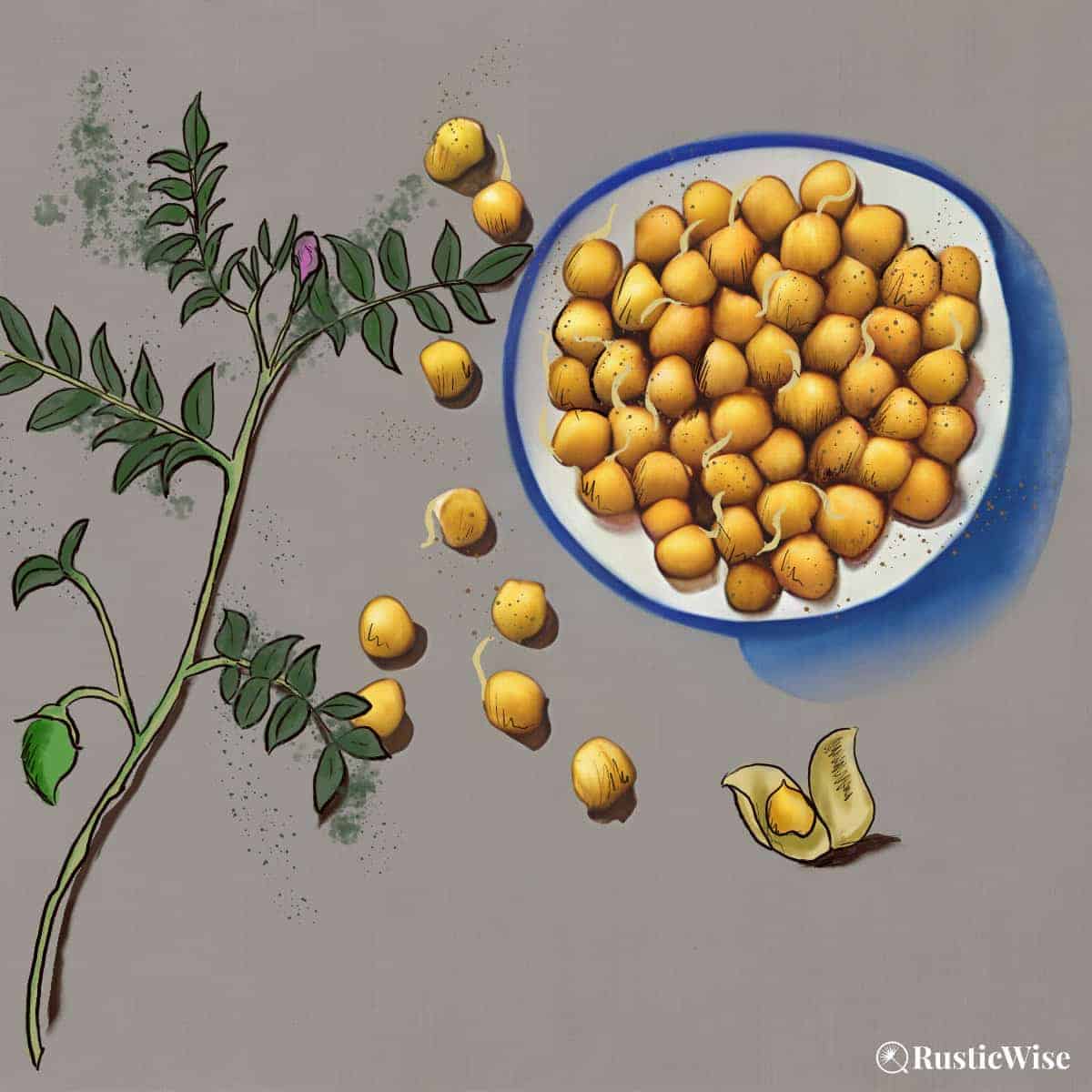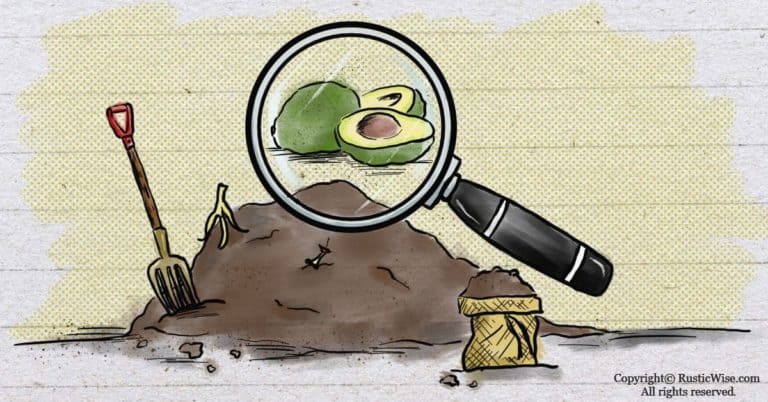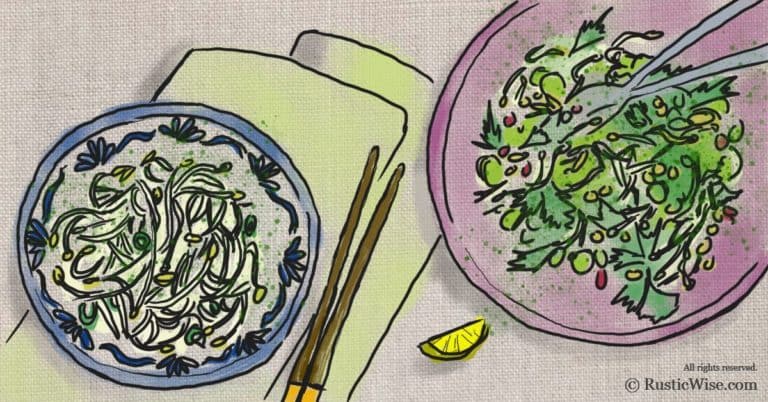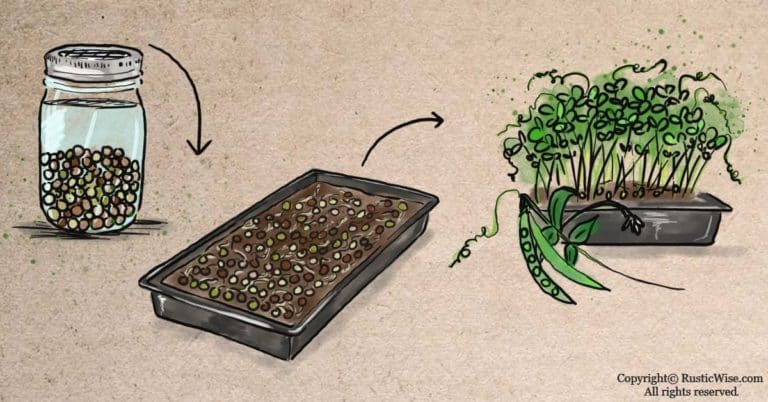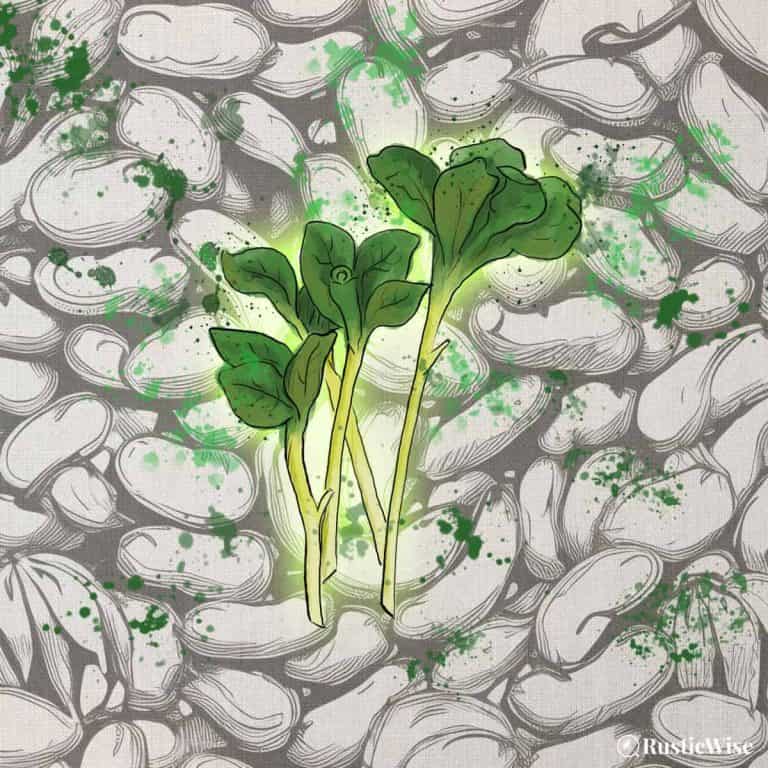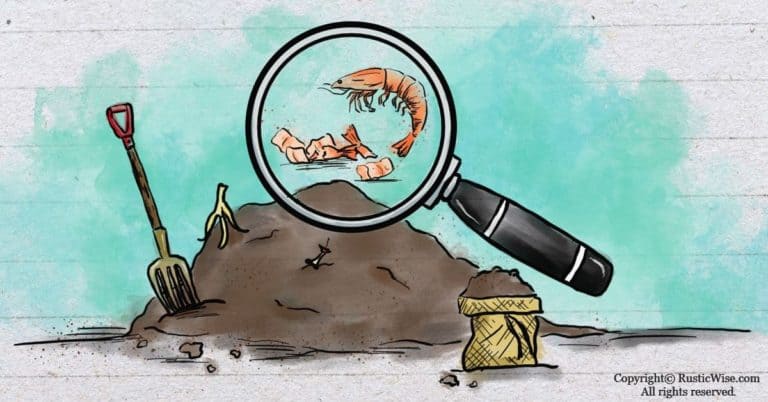How To Grow Chickpea Sprouts (aka Garbanzo Beans)
Chickpeas are a legume that’s packed with protein, but they can be hard to digest. Sprouting them in a jar is a great way to make them more digestible while also adding a new flavor profile to your meal.
Sprouting legumes is a simple process that takes only two to four days and can be done on your kitchen countertop. I’ll show you how to grow chickpea sprouts (also known as garbanzo beans) using a glass mason jar, a sprouting lid (or piece of cheesecloth and rubber band), and some good quality sprouting seeds.
Let’s get started!
A closer look at chickpeas
Chickpeas come from the Cicer arietinum plant. It’s an annual flowering plant that belongs to the pea or legume family (Fabaceae). The seeds or pulses are harvested for their high nutritional content.¹
The pulses go by many names, including chickpea, garbanzo bean, or Bengal gram. (The terms garbanzo and chickpea are used interchangeably in this article and refer to the same seed.)
In North America, we’re used to seeing the round, beige colored “Kabuli-type” of bean. But in other parts of the world (particularly the Middle East and India), they have darker beans with more irregular shapes, the “Desi-type.”²
India produces the largest amount of garbanzo beans in the world, but they are also grown around the globe.
Did you know… This ancient pulse has been traced to recordings as far back as 3500 BCE in Turkey, and about 6790 BCE in France.²
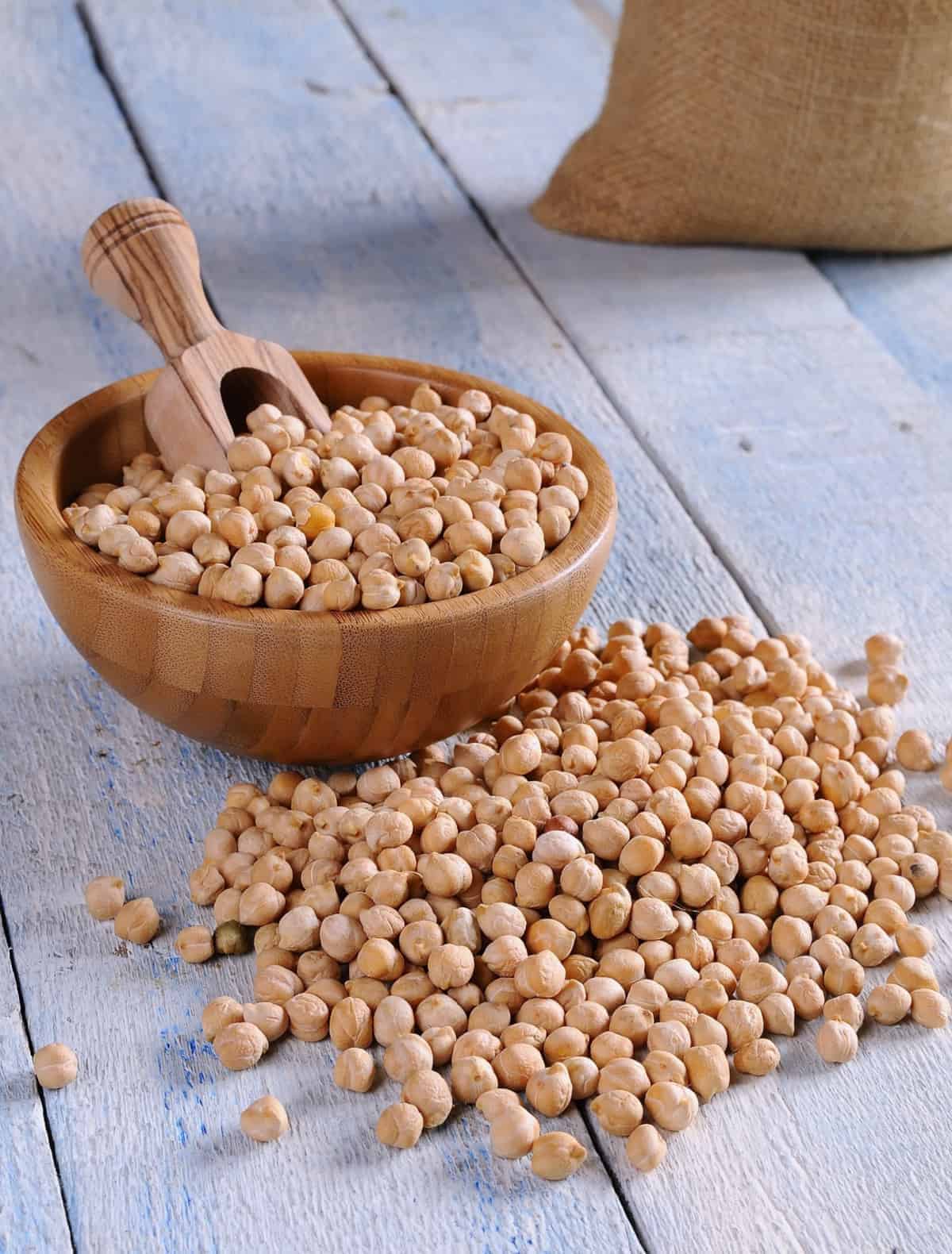
Why bother sprouting garbanzo beans?
Many foods, particularly legumes and grains, are tough to digest. This is because the seeds contain several antinutrients, such as lectin and phytic acid, that block the absorption of nutrients. While cooking helps make these foods more palatable and digestible, so too does sprouting.
While cooking may slightly decrease the amount of nutrients available, sprouting does the opposite—it increases the amount of nutrients available to your body by breaking down phytic acid.
The sprouting process results in greater nutrient availability, better digestibility, and an increase in flavor and aroma.
What are chickpea sprouts, exactly?
Simply put, sprouted chickpeas are the tiny roots that emerge from raw seeds. The dry seeds are soaked in water to coax it from dormancy, and then kept in controlled moist conditions to encourage growth.
Sprouting is the process of soaking, rinsing, and draining seeds to activate their enzymes and begin the germination process.
You eat the seed and shoot/roots.
Do chickpea sprouts taste good?
Like many other legumes, garbanzo bean sprouts share a similar nutty and earthy flavor profile. The short tails have a crunchy texture, while the seeds have a pleasant creamy, earthy, and slightly nutty flavor.
The mild and versatile flavor allows you to use them in many ways. They add a wonderful flavor to curries or stews. They are also great in salads, in sandwiches, and in many other ways that you might enjoy greens or legumes.
What type of chickpea seeds can you sprout with?
When sprouting any type of legume, vegetable, or grain, we highly recommend you use only organic, untreated seeds that are labelled as “high-germination” seeds or sproutable seeds. Look for raw, organic, untreated garbanzo seeds.
Special sprouting seeds have been designed to germinate under regular sprouting conditions (moist and cramped environments). High quality sprouting seeds have also been tested to ensure they are free of harmful pathogens such as E. coli and Salmonella.
While you could try sprouting raw pulses you buy from the grocery store, chances are they will have a lower germination rate.
Can you use canned chickpeas to grow sprouts?
Sadly, no, you can’t grow sprouts from canned chickpeas. This is because the pulses have been heated or cooked during the canning process and will not germinate.
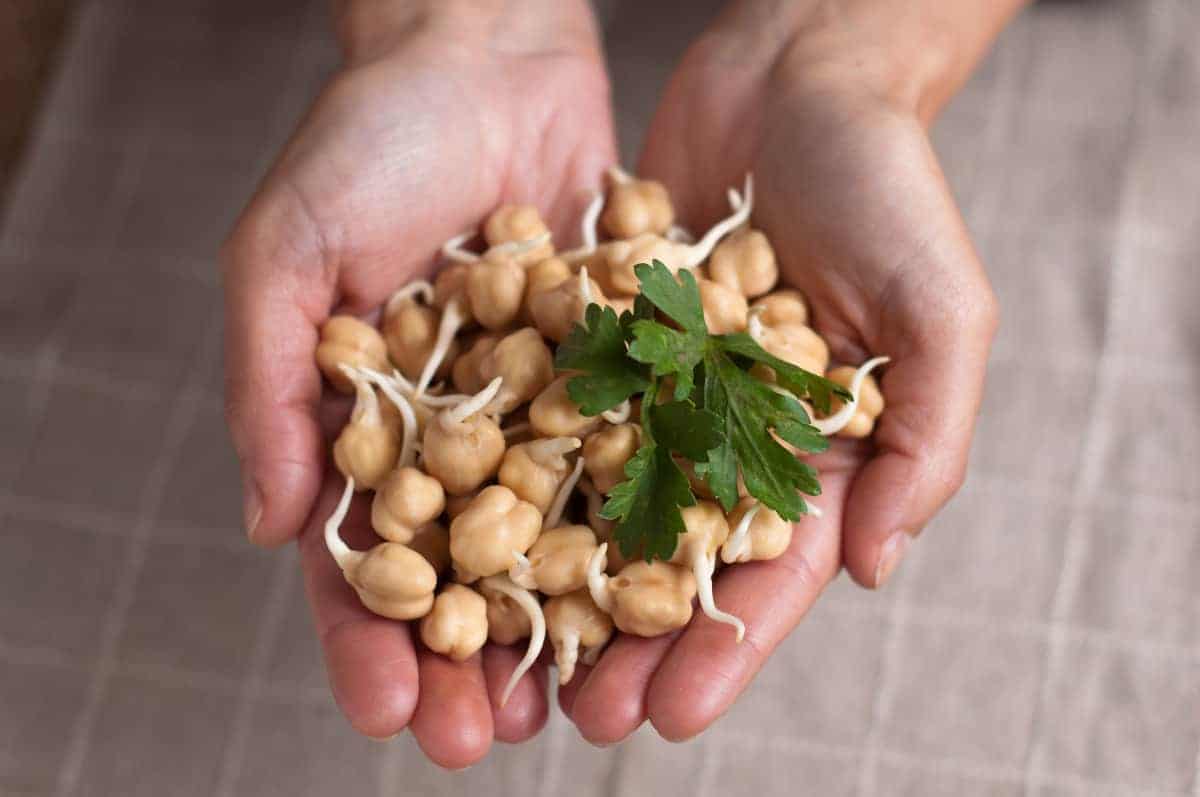
Credit: Deposit Photos
How to grow chickpea sprouts step by step
Ready to increase your plant-based protein intake? These cute, round little pulses are easy to sprout. Like many other bean sprouts, garbanzo sprouts taste best when roots are still small and sweet—less than ¼ inch long.
Bean sprouts that are grown for too long taste bitter.
For those who are new to sprouting at home, please check out our essential guide to sprouting for everything you need to know to get started.
A few basic tips to get you started growing chickpeas at home:
- Keep seeds in dark or low-light conditions: You don’t have to keep them in complete darkness. I often grow sprouts in a darkened corner of my kitchen.
- Keep at room temperature: You don’t need to get too worried about getting the temperature exact (just avoid extreme heat or cold). Somewhere around 70–80 degrees Fahrenheit (21–27 degrees Celsius) is usually good.
- Use cool, clean water to rinse: It’s important to use clean water that’s at least drinking quality. If you have distilled or filtered water, even better.
- Give them plenty of airflow: Sprouts that don’t get enough air circulation are prone to bacteria and mold growth. Therefore we don’t recommend storing them in a cupboard.
Growing tips: Dried chickpea seeds have a lower yield than other types of sprouts (such as broccoli sprouts which have a high yield) as the seed makes up the bulk of the sprout. For example, ½ cup seed will produce roughly 1 cup of sprouts. I suggest starting out with ½ cup seed per quart-sized sprouting jar (to avoid overcrowding). But more experienced growers can increase the amount of seeds to 1 cup per quart jar.
Harvest: Between Days 2 and 4, or to taste!
Supplies you’ll need
- 1-quart glass mason jar
- Sprouting lid or cheesecloth and rubber band
- ½ cup of quality chickpea/garbanzo seeds
- Clean water (filtered)
- Measure seeds: Portion out roughly ½ cup of seeds per quart jar.
- Inspect and wash beans: Do a quick inspection and toss out any damaged beans and other small stones or debris. Place the beans in the jar and rinse with clean cool water several times until the water runs clear.
- Soak: Ensure the beans are fully submerged under water and let them soak overnight, or for 8 to 12 hours. This soaking period helps to activate the seeds. Place sprouting lid or fasten cheesecloth onto the jar with an elastic band.
- Drain: The next morning, drain the soaked water by tipping the jar upside down. You can also rest it at a 45-degree angle inside a bowl for more thorough draining.
- Rinse and drain the chickpeas: After the initial soak, continue to rinse with cool water at least twice a day, or every 8–12 hours. Ensure you drain the jar well to prevent sitting water, which can encourage mold or bacterial growth.
- Harvest: When you’re growing legume sprouts, you can harvest as early as Day 2 or 3. Others prefer to wait until Day 4. I don’t recommend growing much longer than this, or you’ll end up with bitter tasting chickpea sprouts. When harvesting, give your sprouts one last rinse under cold water in a colander to remove any seed hulls or other residue. Allow to drain fully, and pat dry. Keep in the refrigerator.
How to store sprouted garbanzo beans
Keep all harvested sprouts in the refrigerator. Sprouts are best consumed within 2 to 3 days. But with proper storage, you might squeak out a few extra days, up to a week. Store in the fridge in a sealed glass container, plastic baggie, or Tupperware.
Can you eat raw sprouted chickpeas?
The simple answer is that yes, you can eat sprouted chickpeas raw. Uncooked sprouted chickpeas are non-toxic.
On the other hand, you should not eat dried, raw (unsprouted) garbanzo pulses as they are very difficult to digest and contain certain toxins which can irritate the digestive system. (Besides, who would want to eat a rock-hard dried seed?!)
While raw chickpeas seeds contain antinutrients that make them easier to digest, the sprouting process largely destroys or neutralizes these antinutrients. So, as long as you are following the sprouting process (rinsing and draining), raw sprouts are generally safe to consume.
Safety note: Not everyone should eat sprouts raw. Vulnerable populations, including pregnant/breastfeeding women, the elderly, and those with underlying health conditions, are at greater risk of getting sick when consuming raw foods. It’s recommended that these populations cook sprouts first before eating.
Health benefits of garbanzo beans (chickpeas)
These round legumes are a significant source of dietary fiber, protein, iron, and carbohydrates.³
Just 1 cup of raw chickpeas contain 756 calories as well as:
- Protein: 41 grams or 82 percent Daily Value (DV)
- Carbs: 126 grams or 42 percent DV
- Fat: 12 grams or 15 percent DV
- Fiber: 24 grams or 87 percent DV
- Sugar: 21 grams or 43 percent DV
It’s also a good source of B-vitamins (such as folate and thiamin), and vitamin C.
It contains a substantial amount of iron: 48 percent DV. Garbanzo beans are a great source of nonheme iron (plant-based) as are sprouted flax seeds, hemp seeds, and lentils.
Here are a few health benefits of this humble legume:
- Helps build muscle: Garbanzo contains a substantial source of nonheme protein that helps those on plant-based diets maintain and build muscle mass.⁴
- Maintains a healthy body weight: Keeping off the extra pounds is easier when you feel satiated after eating a protein and fiber rich, yet low-fat source of food.²
- Helps keep diabetes in check: According to the Harvard T.H. Chan School of Public Health, garbanzo beans contain amylose, a slow-digesting starch that prevents blood sugar and insulin levels from spiking. Garbanzo also has a low glycemic index (and low glycemic load) which helps those with Type 2 diabetes manage their symptoms.²
- Promotes healthy gut bacteria: Chickpeas contain a soluble fiber called raffinose, which helps promote inflammation in the colon. Plus, the high fiber content keeps your digestive system on track.
- Healthy heart: Garbanzo beans help lower blood cholesterol levels and promote an overall healthier heart with their heart-friendly unsaturated fats.
How to use sprouted chickpeas in the kitchen
- Raw: Enjoy raw chickpea sprouts on salads, wraps, sandwiches, or in raw chickpea hummus.
- Cooked: There are many ways to enjoy this versatile bean. Add to soups, stews, or curries.
- Dry and dehydrate: Sprouted legumes are good candidates to dry and grind into flour. If you have a dehydrator, slowly dry this legume over low and steady heat, then finely grind.
Related questions
Do sprouted chickpeas smell?
No, sprouted chickpeas don’t smell bad (unless they have spoiled). You’ll know your legumes are bad if they start to smell and look slimy. During the sprouting process, they simply smell like a fresh bean.
What beans should not be sprouted?
Not all beans are safe for sprouting. Some types of legumes contain harmful toxins which are only minimized when fully cooked. This includes broad beans (aka fava beans), kidney beans, and lima beans.
👉 If you like this post, see our Essential Sprouting Guide: How To Grow Sprouts at Home. 🌱
Would you like more timeless tips via email?
Fun tips to help you live an independent, self-sustaining lifestyle. Opt-out at any time.


References
- Britannica, Chickpea, plant, https://www.britannica.com/plant/chickpea. Accessed October 2022.
- Harvard T.H. Chan School of Public Health, Chickpeas (Garbanzo Beans), https://www.hsph.harvard.edu/nutritionsource/food-features/chickpeas-garbanzo-beans/. Accessed October 2022.
- MyFoodData (USDA), Chickpeas (Garbanzo Beans Bengal Gram) Mature Seeds Raw, https://tools.myfooddata.com/nutrition-facts/173756/. Accessed October 2022.
- Evans, Doug (2020). The Sprout Book: Tap into the Power of the Planet’s Most Nutritious Food. St. Martin’s Publishing Group. ebook.

Author: Josh Tesolin
Josh is co-founder of RusticWise. When he’s not tinkering in the garden, or fixing something around the house, you can find him working on a vast array of random side projects.

